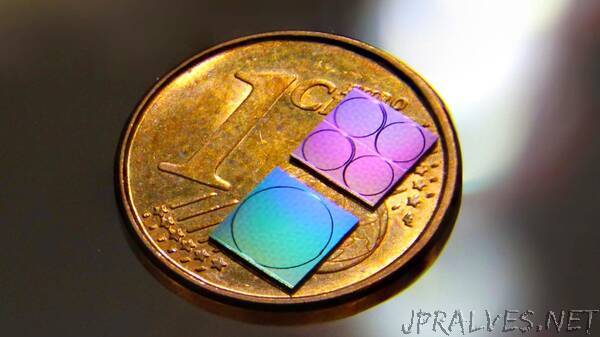
“Using integrated photonic chips fabricated at EPFL, scientists have demonstrated laser-based microwave generators. These microwave signals, as well as their optical carriers, could be used in radars, satellite communications and future 5G wireless networks.
In our information society, the synthesis, distribution, and processing of radio and microwave signals are ubiquitous in wireless networks, telecommunications, and radars. The current tendency is to use carriers in higher frequency bands, especially with looming bandwidth bottlenecks due to demands for e.g. 5G and the “Internet of Things”. “Microwave photonics”, a combination of microwave engineering and optoelectronics, might offer a solution.
A key building block of microwave photonics is optical frequency combs, which provide hundreds of equidistant and mutually coherent laser lines. They are ultrashort optical pulses emitted with a stable repetition rate that corresponds precisely to the frequency spacing of comb lines. The photodetection of the pulses produces a microwave carrier.
In recent years there has been significant progress on chip-scale frequency combs generated from nonlinear microresonators driven by continuous-wave lasers. These frequency combs rely on the formation of dissipative Kerr solitons, which are ultrashort coherent light pulses circulating inside optical microresonators. Because of this, these frequency combs are commonly called “soliton microcombs”.
Generating soliton microcombs needs nonlinear microresonators, and these can be directly built on-chip using CMOS nanofabrication technology. The co-integration with electronic circuitry and integrated lasers paves the path to comb miniaturization, allowing a host of applications in metrology, spectroscopy and communications.
Publishing in Nature Photonics, an EPFL research team led by Tobias J. Kippenberg has now demonstrated integrated soliton microcombs with repetition rates as low as 10 GHz. This was achieved by significantly lowering the optical losses of integrated photonic waveguides based on silicon nitride, a material already used in CMOS micro-electronic circuits, and which has also been used in the last decade to build photonic integrated circuits that guide laser light on-chip.
The scientists were able to manufacture silicon nitride waveguides with the lowest loss in any photonic integrated circuit. Using this technology, the generated coherent soliton pulses have repetition rates in both the microwave K- (~20 GHz, used in 5G) and X-band (~10 GHz, used in radars).
The resulting microwave signals feature phase noise properties on par with or even lower than commercial electronic microwave synthesizers. The demonstration of integrated soliton microcombs at microwave repetition rates bridges the fields of integrated photonics, nonlinear optics and microwave photonics.
The EPFL team achieved a level of optical losses low enough to allow light to propagate nearly 1 meter in a waveguide that is only 1 micrometer in diameter –100 times smaller than that a human hair. This loss level is still more than three orders of magnitude higher than the value in optical fibers, but represents the lowest loss in any tightly confining waveguide for integrated nonlinear photonics to date.
Such low loss is the result of a new manufacturing process developed by EPFL scientists – the “silicon nitride photonic Damascene process”. “This process, when carried out using deep-ultraviolet stepper lithography, gives truly spectacular performance in terms of low loss, which is not attainable using conventional nanofabrication techniques,” says Junqiu Liu, the paper’s first author who also lead the fabrication of silicon nitride nanophotonic chips at EPFL’s Center of MicroNanoTechnology (CMi). “These microcombs, and their microwave signals, could be critical elements for building fully integrated low-noise microwave oscillators for future architectures of radars and information networks.”
The EPFL team is already working with collaborators in US to develop hybrid-integrated soliton microcomb modules that combine chip-scale semiconductor lasers. These highly compact microcombs can impact many applications, e.g. transceivers in datacenters, LiDAR, compact optical atomic clocks, optical coherence tomography, microwave photonics, and spectroscopy.”
